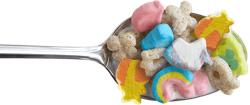As a kid I was always up at dawn. Every day was an adventure and I was eager to get started. I’d teeter downstairs and join my dad, who was inevitably sitting in his boxers, leaning on his elbows, updating his to-do lists in his back-slant lefty handwriting.
Mom delivered three flavors of breakfast cereal on a silver platter, along with milk, juice, and sugar. Grape Nuts, for her. Cinnamon Life, for me. Shredded Wheat, for nobody I knew. Nothing for Dad — he had cigarettes for breakfast.
I was allowed to add one spoonful of sugar to my cereal. I loaded the spoon as full as possible, wincing at every grain that slid off, and gently poured the whole load into a single little mountain atop my cereal. I added milk gently, then started breakfast by eating the sugar mound in one bite.
All our cereals were tan. Mom didn’t want us getting any ideas about colorful food. Of course she didn’t take me grocery shopping — had I seen the long aisle of neon-colored cereals with their come-hither names, I would have vapor-locked.
When Life cereal released its first “Mikey” commercial, I was mesmerized. We shared a name and a cereal — that meant we were probably related, and his brothers looked a lot nicer than mine. It was exciting. So I was caught off-guard when a schoolmate sneered at me, “Hey Mikey! He eats everything!” Another did the same. Then dozens. At each offense I would try to correct them: “Uh, that’s not how the commercial goes—” but by then they’d be laughing down the hall, satisfied that they’d used my head as a stepping stone to pop culture fame. Forty years later I still hear the taunt, still incorrect.
Occasionally I would ask Mom to get one of the other cereals I saw on TV: Count Chocula, Quisp, or my favorite, Cap’n Crunch*, made from corn, oats, and glass shards. She’d react as if I has asked for a car. Too expensive. We don’t do that. Not good for you. Once she relented and bought a box of Lucky Charms. My siblings immediately dug their grubby hands deep into the box, plucking out the pink hearts, yellow moons, orange stars, and green clovers, leaving me only the colorless oatey remains, about as exciting as Alpha-Bits.
Years later, my daughter asked for a box of Froot Loops. I explained just as my mom would have: such cereals were made of cardboard, the colors were artificial, they had no nutritional value, and their manufacturer can’t spell. I plucked a box of Life cereal off the shelf for me, and gave her permission to choose something of equal nutritional value. She held a box of Loops next to mine and compared labels. I learned from a seven-year-old that Froot Loops has fewer calories, less sugar, and more vitamins than Life cereal. Cracklin’ Oat Bran, my other healthy favorite, had the same fat as four slices of bacon—with sugar on top.
The 1950s were the Golden Age of Sugar, and most cereals bragged about it: Sugar Frosted Flakes, Sugar Pops, Sugar Smacks. They all still exist and with the same heart-racing content, but they’ve all been renamed to protect themselves: Frosted Flakes, Corn Pops, Honey Smacks. The one which started it all in 1948, Sugar Crisps, now goes by Golden Crisps. Cowards.
After the Great Granola Scare of the 1960s, marketers gave up on pretending to be healthy and began blatantly naming cereals after candy. Oreo O’s. Reese’s Puffs. Hershey’s Cookies & Creme. “Cream” had to be re-spelled since there was no real cream in it, but they had no problem using “cookies.”
Except for Cinnamon Toast Crunch, no notable cereals have been introduced in the last forty years. The current fad is retro-sentimental: cereal “bars” are popping up, where you can choose from all the favorite cereals of your childhood, then mix-and-match them to create “recipes.” It’s as close as some people come to cooking.
Almost every cereal commercial ended with “Part of a nutritious breakfast!” It was part of mine. It just wasn’t the nutritious part.
* In 2013 the Wall Street Journal reported that the three stripes on Cap’n Crunch’s uniform signify he was a commander, not a captain.


0 Comments